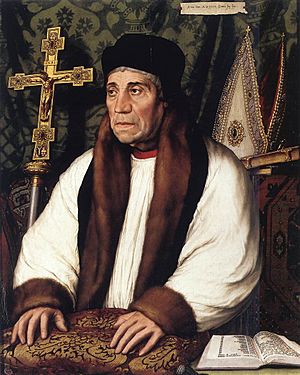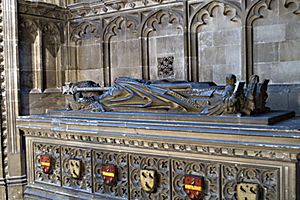William Warham facts for kids
Quick facts for kids The Most Reverend and Right Honourable William Warham |
|
|---|---|
| Archbishop of Canterbury | |

Portrait by Hans Holbein the Younger (1527)
|
|
| Church | Roman Catholic |
| Appointed | 29 November 1503 |
| Reign ended | 22 August 1532 |
| Predecessor | Henry Deane |
| Successor | Thomas Cranmer |
| Orders | |
| Consecration | 25 September 1502 by Richard Foxe |
| Personal details | |
| Born | c. 1450 |
| Died | 22 August 1532 Hackington, Kent, England |
| Buried | Canterbury Cathedral, Kent |
| Denomination | Roman Catholic |
William Warham was a very important leader in the English church. He was the Archbishop of Canterbury from 1503 until he passed away in 1532. This was a powerful role, like being the head of the church in England.
Contents
Early Life and Education
William Warham was born around 1450. His father, Robert Warham, lived in Malshanger in Hampshire, England. William went to school at Winchester College. He also studied at New College, Oxford, which is a famous university.
Starting a Career in Law
After finishing his studies, William Warham became a lawyer. He taught law in both London and Oxford. Even though his father was a farmer, William's brother, Sir Hugh Warham, became quite wealthy.
Joining the Church and Government
Later, William Warham decided to become a priest. He held two church positions and became the Master of the Rolls in 1494. This meant he was in charge of important legal records.
King Henry VII saw that Warham was a very smart and helpful diplomat. A diplomat is someone who helps countries talk to each other. Warham helped arrange the marriage between King Henry VII's son, Arthur, Prince of Wales, and Catherine of Aragon. He also worked on trade agreements with other European leaders.
Becoming Archbishop of Canterbury
In 1502, Warham became the Bishop of London. Soon after, in 1504, he was given two even bigger jobs. He became the Lord Chancellor, which was a top government role. He also became the Archbishop of Canterbury, the most important church leader in England.
In 1506, he became the Chancellor of Oxford University. He kept this job until he died. In 1509, he led the wedding ceremony for King Henry VIII and Catherine of Aragon. He also crowned them as king and queen.
As archbishop, Warham sometimes made decisions that caused disagreements. He had a serious argument with another important bishop, Richard Foxe, in 1512. Because of this, Warham started to step back from some of his duties. In 1515, he resigned as Lord Chancellor. Thomas Wolsey took over his role.
Warham was present at a famous meeting called the Field of the Cloth of Gold in 1520. He also helped Wolsey look into the validity of King Henry VIII's marriage to Catherine in 1527.
During the king's efforts to divorce Catherine, Warham was an older man. He was supposed to help the queen, but he was afraid of making the king angry. He often said, ira principis mors est, which means "the king's anger is death." Because of his fear, he did not help the queen much. He even signed a letter to Pope Clement VII asking the Pope to agree to King Henry's divorce.
In 1531, Warham led a meeting where the church leaders agreed to pay King Henry £100,000. They also accepted Henry as the "supreme head of the church," but added "so far as the Law of Christ allows."
In his final years, Warham showed more courage. In 1532, he spoke out against new laws about the church. He compared King Henry VIII's actions to those of Henry II. He also used Magna Carta to defend the church's freedom. He tried to find a middle ground during the "Submission of the Clergy," but he was not successful.
Death and Legacy
William Warham was known for being generous in his public life and modest in his private life. He passed away on August 22, 1532, while visiting his nephew, who was also named William Warham. He was buried in Canterbury Cathedral. After his death, Thomas Cranmer became the new Archbishop of Canterbury. The Warham Guild was named after him.
Images for kids



